Mad Max meets Lord of the Rings
This story begins with historical fact, which eventually leads to speculation. At this stage, it is a draft history of a land that Australia might have become if it had been colonised by Vikings. While offering an amusing mental diversion, it also aims to provide an opening for some of the possibilities of settlement in the southern continent—possibilities that help put the English settlement in a broader context.
The story begins at the end of the last millennium.
- The Varangian guard
- Ragnarök Now
- Valhalla postponed
- Hel and back
- Not like old times
- Where sea and land meet
- Woomera the crafty
The Varangian guard 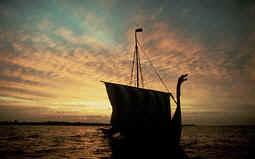
In 980AD, the Russian Tsar Vladimir converted to Orthodox Christianity. At token of his devotion, he sent 6,000 of his soldiers, mostly Vikings, to assist the Emperor of Constantinople, the ruthless Basil II. These soldiers became known as the Varangian guard. Still proud of their pagan gods, especially the thunder god Thor, the Varangians find this Christian deity hard to swallow. Disaffection with Basil smoulders, fanned by Muslim spies who infiltrate their ranks and cleverly interpret Viking mythology according to their own prophesies. The spies show their Viking friends the astrological signs that indicate the immanent arrival of the apocalypse known in Norse mythology as "Ragnarök". Ragnarök now 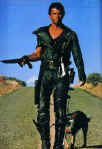
Ragnarök is a final battle in which the gods—together with the fallen soldiers residing in Valhalla—struggle with the evil giants lead by Loki. At its climax, Jormungand (the ‘world serpent’) and Thor are locked in mortal combat. Ragnarök concludes with a great fire that consumes the world. The spies explain to the soldiers how the ‘White Christ’ they serve is in league with the giants against Thor. And maps are revealed that indicate the location of Valhalla in the antipodes. They propose a plan to sail to this land to the guards may be there in time to join the final battle. Such news confirms Viking suspicions about the growing Christian empire and offers a definite course of action. Not all agree to leave, but those remaining swear not to reveal the rebels destination. Harald the Restless leads his rebel group of 600 Viking families south of Constantinople to Oman. Despite concern at the crude habits of this rough guests, Omani welcome the Vikings as invaluable help in building their fleet for trade with China. 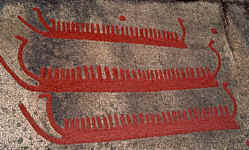
For more than a year, the Vikings assist the Omani with the construction of their ships. Finally, in the year 998, the Vikings lead the Arab traders on a long hazardous voyage along the Indian coastline to the land of Java. Now at their destination, the Arabs are anxious to dispose of their filthy companions and send them what they think is a wild goose chase to the Valhalla further to the south. The Vikings eventually land on the top of the southern continent. Valhalla postponed At first, the Vikings carry on their natural ways. They gorge themselves on local seafood and rampage through native camps. However, they soon find themselves in need of assistance to locate their promised Valhalla. The Vikings adopt a friendlier attitude to the tribe on which they depend. Knowing nothing of Viking history, the local elders assume they come to gather more people for the land of the dead from which they come. When the Vikings try to explain the myth of Jormungand, the elders translate this into their own mythology as "Ngalyod", the rainbow serpent whose movements made passages through the land for water to flow. They then gesture to their visitors the journey of Ngalyod in mountains to the south. Emboldened by information they think will lead them to Jormungand, the Vikings march further south, assisted by a network of Aboriginal communities. The trust between these two peoples from opposite sides of the world grows steadily. Eventually, they come to the place where the serpent is meant to preside, but what they see is just desolate landscape, covered by smouldering grasses. At first, the Vikings are left to presume that their fabled Ragnarök has already taken place and they are too late to participate in it. This causes great consternation in the beleaguered community of 800 men, women and children. There is nothing in Norse mythology that tells of what if anything follows the firestorms of Ragnarök. Hel and back Some of the more hot-headed warriors claim that their Aboriginal friends are the burnt remnants of Loki, and they have been led astray to the terrible underworld of Hel. A fierce argument ensures between them and the more moderate voices. During the course of their argument, distant thunder can be heard, leading some to think that Thor might still be alive. In the middle of this argument and rainstorm descends, filling the land with rivulets and waterfalls. The Aboriginal guides seem most excited and the Vikings learn from them about the manifestation of their rainbow serpent. Their leader, Sigmund the Reasonable, is led to a particularly strong waterfall where he is shown what appears to be a rainbow serpent. Sigmund returns to this people and revises the story of Ragnarök to accommodate an offspring of Thor, whose appearance as a snake douses the flames of Ragnarök, allowing new life to emerge from the devastation of fire. Not all are convinced, however, and Inveld the Furious leads a small but rowdy group of warriors back to where they arrived. In the meantime, the Sigmund’s people settle on the land, learning to survive at hunting with their Aboriginal hosts. They find a reliable source of fresh water, from which they begin agriculture on a small scale. A couple of men with knowledge of mining manage to find sources of iron in the hills. From this, they begin to fabricate weapons for hunting, including a particularly deadly form of boomerang. The boomerang and the kangaroo inspire experimentation with aeronautics. Over the course of several generations a very primitive helicopter is developed that hops along the landscape. Meanwhile, Inveld’s warriors operate like lawless pirates along the coast of the continent. They indulge themselves on rich sea-life, coming to land occasionally to steal women. Eventually, they make their way to larger islands on the south-east of the continent. After many generations, they meet another warlike people with whom they engage in fierce battle. Weakened after many years of indulgence, the Vikings succumb in battle and are subsumed into the Maori peoples. Their knowledge of the larger continent proves useful later in extending the range of the Maori activities. Not like old times 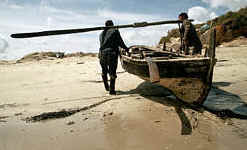
By 1450, the two Viking groups eventually meet up. The seafarers are amazed at the technological advances made by their land-loving ancestors. They look with envy at the violence they might wreak if given access to these mechanisms. Pirates sneakily accept the welcome offered to them, but strike at night by first killing their leader and then seizing the machines. Villagers flee to the hills before they can be captured, so the pirates are left to clumsily work out how these mysterious flying machines work. In the process of their experiments, they manage to break most of the equipment and are left no better off than when they began. They decide to venture into the continent to track down the villagers. They notice fires on a hill and advance in battle formation. Their leader Aratoa notices a stick flying through the air to him and reaches out to grab it. The stick (a "Gungnir") is actually made of sharpened steel and slices off his fingers before returning to its point of origin. This blow sends the band of warriors into disarray and they retreat back to the sea. For a long time nothing is heard of these pirates and the village warily returns to its original location, which it begins to fortify. Their civilisation advances on, forming a network of mines and forges throughout the continent. Wonderful jewellery is made using the rich gold deposits found in the interior. Using the hopping machines ("sleipnir"), greater inter-communication develops between Aboriginal communities and their languages begin to share many common words. The pirates in the meantime play sport with whatever they can find, including the odd whaling vessel from the other side of the world. Their incursions into the continent become rarer as coastal villages develop more sophisticated defences. Instead, they begin to concentrate their activity to the north, where they throw in their lot with the Bugis and Macassans in preying upon small trading vessels. They meet their match, however, with the arrival of the Europeans, particularly the Portuguese and the Dutch, whose cannon power overwhelms their bows and arrows. Where sea and land meet In 1634, their leader Moanok the Ready decides that they only way they can counter these new weapons is by means of an alliance with the miners, in which they can use their sophisticated machines. The miners are naturally wary of their approach, but grow in confidence when Moanok offers to give all five of his wives as guarantee to the deal. Voices among them also see the usefulness of this alliance in repelling a potentially more dangerous enemy. After the Treaty of Woomera a naval force is established without peer in south-east Asia. The ensuing sea battle with the Dutch navy is intense and bloody. With greater agility of the Woomera vessels eventually outmanoeuvres the more cumbersome war ships and the Europeans are forced to withdraw to safer ports. Victory celebrations justify this uneasy alliance between the brains and the brawn of Viking descendants. From that day, the nation of Woomera is ruled by a marriage in which the King is drawn from land-lover stock, of mixed Aboriginal and Viking blood, and the Queen from sea-farer stock, descended from Viking and Maori blood. Woomera the crafty Woomera develops as a proud nation, fiercely opposed to the Christian empires constantly knocking on their doors. 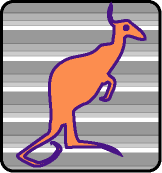
Today, Woomera is distinguished for its marriage of technology and ornament. Modernism has little influence in design; form usually goes far beyond function. Their hand tooled machines were much celebrated by the leaders of the English Arts & Craft movement, William Morris and John Ruskin. The Woomera workshops established by Morris still produce the fine fabrics and wallpapers that are found in every Viking home. Thanks to trade protectionism and resistance to economic rationalism, Woomera manufactured goods are prized rarities overseas. Woomera cities are densely inhabited with large communal buildings for meals and gatherings. The biography of an average citizen is marked by a formal rite of passage, in which initiates are removed from their families for ordeals of endurance in the harsh interior of the continent. The violence of this method is the source of much criticism from outside Woomera. Such criticism only strengthens the nation’s resolve to maintain its customs. Naturally, a modern pagan nation is also a great challenge to the many Christian missions around the world. Conversely, mystics and their followers are drawn to Woomera from all around the world, particularly from Scandinavia. These ‘New Vikings’ are the butt of most Woomera jokes. The summer and winter solstices are moments of great celebration. Winter solstice is marked by huge bon fires on which are placed wooden boats filled with crash dummies. And in summer, the seas are filled with the holiday crowd trying to catch the next wave on their Bugis boards. On the world stage, Woomera has tried to maintain a neutral position. Fascist sympathies were stirred in the 1930s, though the attack from Japanese forces helped consolidate the nation to defend its shores. Since then, Woomera has been a fierce advocate of indigenous peoples. However, its treatment of philosophy as a treasonable offence as troubled many Western countries. Woomera representatives in international forums are renowned for their rudeness. More sophisticated nations occasionally swallow their pride in order to gather information about Woomera technology, particularly their satellite technologies. Around the globe, people encounter Viking backpackers trekking through the most remote areas of their world. Probably the most exotic location is the Viking Bed and Breakfast in Antarctica. The ‘down-under’ world of Vikings in Woomera adds a colourful footnote to the book of mankind, though it’s a book that few residents of this country are likely to read.
**The above was constructed with the assistance of a workshop held on 1st August at the new Object Galleries on Circular Quay, Sydney. Thanks to Vivien, Corinna, Tracey, Catherine, Mary and Anne.
Responses to the story are most welcome and will be incorporated into the final version.